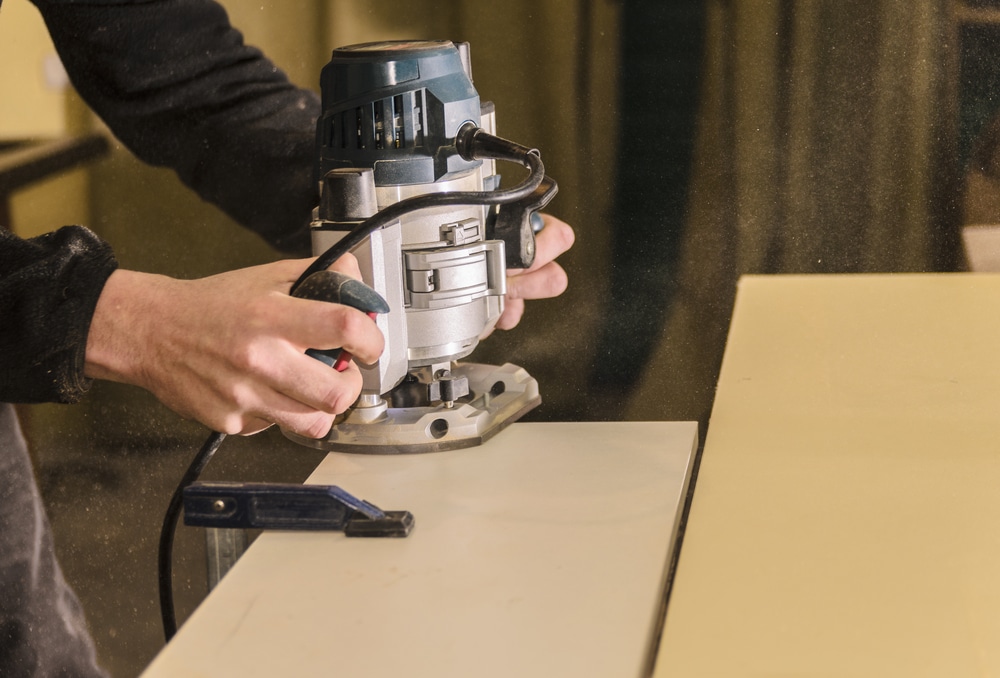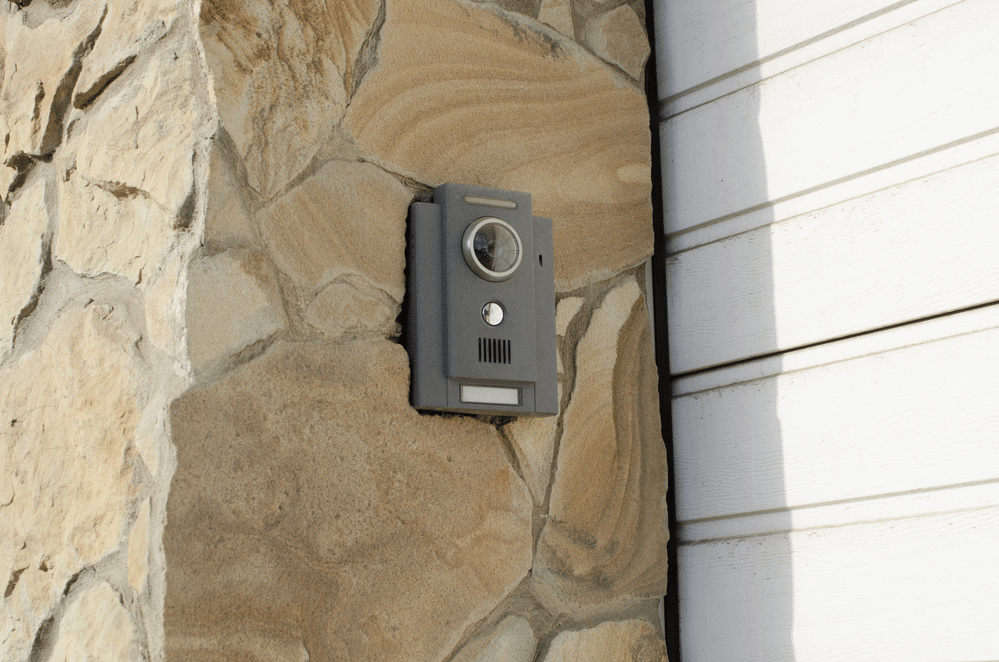Last Updated on
Routers are popular because they are one of the most versatile tools for woodworkers. While full-size routers perform heavy-duty tasks in your workshop, there are several advantages to using a trim router or palm router. Beyond getting rid of that extra weight, these smaller tools contain a base plate and offer better control than a standard router. But what is the difference between a palm router and a trim router, and which of these two options is preferable?
As they are inexpensive and practical, you may find routers in most woodworking shops worldwide. But it might be hard to determine which choices are appropriate for specific tasks, like edge work or trimming shelf lipping. Read on to learn more about the functional differences between a palm router and a trim router, including how they are used and what makes them different.
What Are Palm Routers?
As its name suggests, the palm router or hand router is smaller and fits in the user’s palm. These woodworking tools come in both corded and cordless routers. More undersized than a full-size router, these are ideal for smaller projects, like trimming door frames or cutting decorative patterns into wood panels. They’re also easy to handle and great for beginners just starting their woodworking hobby.
The main thing that determines what tasks your router can do is how much horsepower it has. Lower horsepower machines cannot manage specific jobs compared to higher horsepower machines. Palm routers typically produce between 0.5 and 1 horsepower.
Even though palm routers can’t do more complex woodworking jobs, they offer one distinct benefit over trim routers. They can accomplish more precise and accurate work than a trim router could. A palm router is ideal, given the exact nature of some woodworking projects.
Palm Router Uses
You may use your palm router for a variety of tasks, such as:
- Engraving small signs
- Trimming off rough edges
- Smoothing and finishing board edges
- Trimming mortises and tenons
- Making decorative edging for drawers, doors, and cabinets
Handheld Router Styles: Fixed and Plunge
Vinnie's Safety Tip of the day: handheld router (nsfw) pic.twitter.com/7WngDDuTsv
— 𝓑𝓪𝓵𝓸𝓷𝓮𝔂 𝓡𝓲𝓿𝓮𝓻 (@BaloneyRiver) January 18, 2021
Handheld routers are designed in two styles: plunge routers and fixed-base routers. While they both perform the primary function of any wood router, they offer different features and capabilities.
A compact router may be used either manually or secured to a table. While some prefer to create their own, you can get wood router tables in stores that are made to accommodate the vast majority of current models.
Fixed Router
With the help of its powerful motor, fixed-base routers can cut intricate designs into many types of wood. They are a vast improvement over standard-size routers. They can do anything, from cutting the laminate to size to routing dados and mortises for wood framing or cabinetmaking.
However, “fixed-base” is perhaps not the most accurate description. You may lock the height and positioning of the base of a machine into place. There are also little knobs for making fine adjustments. Once the depth adjustment is set, the tool height won’t shrink or grow, allowing the bit to be adapted to the precise depth required for the job.
Plunge Router

Fixed-base and plunge routers do the same things, like shape and size wood with high-speed motors.
Plunge routers don’t have a fixed base but rather spring-loaded handles that lower the plunge base and router’s motor over the surface being worked on.
The plunge base lowers to make a router cut adequately. Hold the wood being worked on firmly against the bit. Whenever the user is done cutting, they can let off the tension, and the plunge base will rise, taking the cutting bit with it.
It would be best to consider their weight, precision, and price differences to decide between a plunge router and a fixed-base router.
- Weight: Compared to a plunge router, fixed base models are more portable and lightweight.
- Precision: Though a plunge router provides greater flexibility, a fixed router is preferred for its accuracy.
- Edging: A plunge router is appropriate for applications that need working from above, while a fixed base router is suitable for edgework.
- Cost: A standard plunge router costs more than fixed base routers.
Router Table
When used for stationary routing applications, compact routers are mounted upside down on a router table or, in some instances, on a bench top, with the cutter pointing upwards.
The operator may adjust the variable speed of the router bit on a router table and direct the motion by advancing the material toward the router cutter.
In cases when the material being worked on is too tiny to hold the base of a portable router, a router table is the best option. You can manipulate small stock pieces around the cutter with push tools.
What Are Trim Routers?
Initially developed for use in trimming laminate wood flooring, a trim router is an important part of any woodworker’s tool arsenal. The widespread use of these routers can be attributed to the tool’s adaptability, which enables it to be used for a wide range of projects beyond only flooring and cabinets and worktops.
The primary distinction between a trim router vs a palm router is size, which determines the scope of work you can do with each. A trim router’s maximum power might range from one to three horsepower. That’s a whopping three times the height of most palm routers, meaning your next big job just became much more manageable.
Its size and strength allow it to accomplish jobs that the palm router, while convenient, could not.
Trim Router Uses
We were getting things done with not just 2 but 3 Ridgid trim routers rounding out edges. pic.twitter.com/ChWkYwGHZX
— Trevor Wheeler (@Wheel_on_Wheels) June 12, 2018
A trim router is a must-have tool for any serious woodworker used to a regular router with variable speed. Its versatility and power make it an essential piece of equipment, especially when working with hardwoods or other materials that are difficult to cut through. You can use trim routers to:
- Rout edges and profiles
- Clean up the surface of rough lumber
- Create decorative accents on doors and cabinets
- Duplicate wood objects
- Cut shelf lipping
- Create detailed inlays
Palm Router vs Trim Router: Main Differences
When searching for a new router, there are a few specifications to remember. The ideal router for your needs has settings tailored to your job and the materials you’re working with.
While the differences between two routers might seem minute, they can significantly affect performance and your finished product.
Speed Control
The user can select a variable speed between 10,000 and 30,000 revolutions per minute (RPM). Depending on the task, you can modify the tool to use a slower speed for more control of the router bit or a faster rate to make quick cuts.
You should use slower speeds when utilising larger bit sizes, often found on a trim router. When using smaller bit sizes, however, faster speeds are better.
Peak and Sustained Power
The most important aspect of a router is its power, which is expressed in terms of horsepower. The power output from each router will vary between its peak and sustained levels. Output is the maximum power a router can provide for short bursts of time, and it is the highest power for extended periods.
Compared to trim routers, which may reach 2 or 3 horsepower, palm routers generally have less power, with a lower maximum output of around one horsepower. Unless you’re dealing with massive workloads, you should only need that much power from your router.
Start-up Time
It would help if you approached trimming with the same caution you would use while starting a vehicle. With the slow start function enabled, the tool will operate at a reduced rate before rapidly picking up velocity as needed. If you turn it on and it goes straight to full throttle, it might quickly get away from you, destroying your work or harming the user.
Router Bits
Router bits are the blades of choice for many woodworkers. Each bit performs its specific task by cutting away tiny pieces of wood until your desired shape is achieved.
They come in several different sizes and styles, each designed to perform a specific task. The most common bits include:
- chamfer
- cove
- dovetail
- flush trimming
- rabbeting
- round over
Instead of high-speed steel, carbide-tipped bits provide a cleaner cut. They are also less likely to cause the wood to catch fire. Bits with carbide tips are more expensive in the long run, but they maintain their sharpness for much longer.
Prices
The cost of the router should be your final deciding factor. Most routers don’t cost too much, but it’s easy to spend more money than needed if you don’t watch out. It won’t shock you to learn that the higher the list price of a router, the more functionality it has. When deciding how much you can afford to spend on a router, you must consider the many functions you’ll need.
Would You Go for a Palm Router or a Trim Router?
The router is one of the most versatile tools in any woodworker’s arsenal. It can be used for many applications, from cutting mortises to flush trimming to creating decorative edges.
Palm routers are more portable and convenient, making them ideal for precise work on smaller scales, such as ornamental moulding, engraving, and rounding over sharp edges. On the other hand, a trim router is superior for more significant tasks like building shelves, fences, or signage.
Paul is the type of person who never met a problem he couldn’t fix. He can always be found tinkering with something in his house, even if it isn’t broken! His tips and tricks are often shared on our site. He’s the one you call when something breaks because he has been known to improvise fixes for everything from leaky faucets to malfunctioning dryers.



